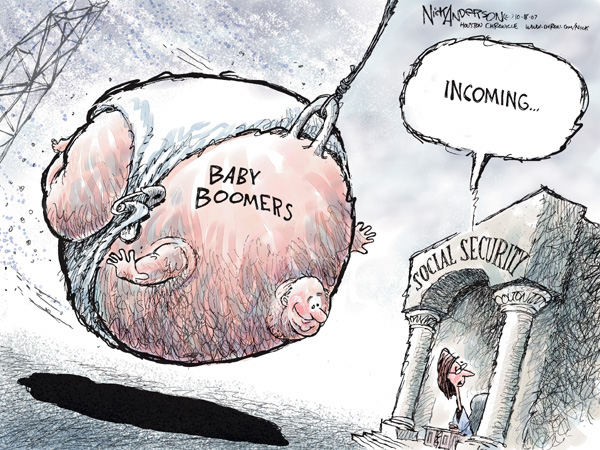
A medieval map of the world conceptualised it as a cloverleaf, in which Jerusalem occupied the central node, with three major areas of political influence spreading out from it. In the 16th Century, it seemed like the three major areas of the world were Europe, Asia and Africa, with America looking on from afar.
Occupying a place at the confluence of several major trade routes was the basis for Jerusalem’s rise to prominence. It allowed them to gather massive amounts of taxes, and to easily send Abrahamic missionaries to all parts of the world. Eventually, so many of those missionaries had reached Europe that it fell under the dominion of the God of Abraham.
In the World Age stretching from the end of the Egyptian Age to now, otherwise known as the Age of Pisces, the God of Abraham reigned triumphant, and the world seemed to be centered on Jerusalem.
The Age of Pisces, however, is ending, and the Age of Aquarius is beginning. This term refers to a new spiritual age, but, as per the Second Hermetic Principle, these spiritual changes will be reflected in the material world. A new spiritual order will mean a new geopolitical order. There are several clues as to what that new order might look like.
The coming geopolitical age of the world will have a similar structure to the old, in that there are three major powers, each of which is either allied or at war with the other two. The major difference is that the new geopolitical order will be based around the East instead of the West.
The shape of this new world will be like a three-leaf clover based around Singapore. Instead of Jerusalem, Singapore will be the highly wealthy trade hub at the centre of the world. Instead of Europe, Asia and Africa, the world powers will be China, India and the Anzac Empire.
That Singapore will be the centre of the new age of the world is guaranteed by the fact that whoever controls Singapore controls the Malacca Straits, and whoever controls those straits controls a chokepoint that not only connects the Pacific and Indian Oceans but which also oversees half of the world’s shipping. The Malacca Straits are the Levant of the new age – they are where worlds collide.
That China and India will play major roles in the new order of the world is appropriate for two major reasons: their vast populations and their previous historic influence. At time of writing, in 2021, both of these nations possessed immense untapped potential.
The populations of China and India will wane as they continue to become wealthier. The Chinese birthrate is already below replacement level, and below one child per woman in major centres like Shanghai and Beijing. The Indian fertility rate has fallen to replacement level, and looks set to fall below that in coming decades.
Both of these major powers will be moderately economically advanced by the time the new age of the world is underway (instead of being highly advanced in the cities and backwards elsewhere). Their great power and influence will come from their vast populations, which should still be around a billion each by the end of the century.
The birthrate of Anzacistan has also stabilised (although it’s higher than that of wealthy Chinese and Indians), but the Southeasterners have one crucial advantage over India and China: they can take mass amounts of immigration.
The population of Australia and New Zealand combined is, in 2021, only 30 million, but that is similar to the American population of 1860. So although the combined Anzac GDP might be only 1.6 trillion, compared to India’s 2.6 trillion and China’s 14.8 trillion, the Anzac Empire has vast untapped potential in the form of underpopulated land.
By 1890, the American population had grown to 60 million, and by 1930 it had swelled to 120 million. If the Anzac Empire would enact policies that allowed for a similar level of population growth, then, assuming the average quality of the genetic infrastructure was maintained, it could be a force as powerful as today’s Russian Federation by the end of the 21st Century.
Africa and Europe will continue to decline into irrelevance. As of today, both Britain and France could project more power into Singapore than any of China, India or an Anzac Empire. In the new age of the world, both Britain and France will fall away, ruined by their suicidal decision to accept mass Muslim and African immigration. Africa doesn’t have the genetic infrastructure to ever become a power.
In the beginning of the new age, the Anzac Empire would work very closely with America. This is a natural alliance on account of the shared culture, history and values of the two nations. It would also work very closely with Singapore (New Zealand’s ban on foreign buyers of property has two exemptions: Australians and Singaporeans), for similar reasons.
As the new age progresses, the Anzac Empire will become a great power in its own right, and America will once again take more of a support role in a wider Pacific sense. The basic geopolitical order of the new age of the world is all but certain at this point, barring any major upheavals.
*
If you enjoyed reading this essay/article, you can get a compilation of the Best VJMP Essays and Articles of 2019 from Amazon for Kindle or Amazon for CreateSpace (for international readers), or TradeMe (for Kiwis). A compilation of the Best VJMP Essays and Articles of 2018 and the Best VJMP Essays and Articles of 2017 are also available.
*
If you would like to support our work in other ways, please consider subscribing to our SubscribeStar fund. Even better, buy any one of our books!



